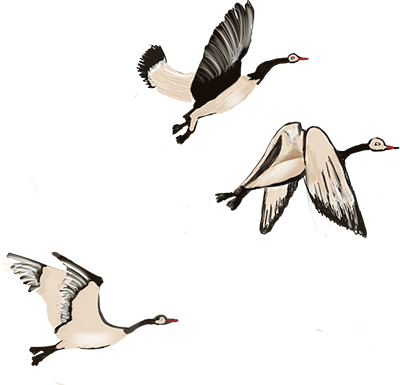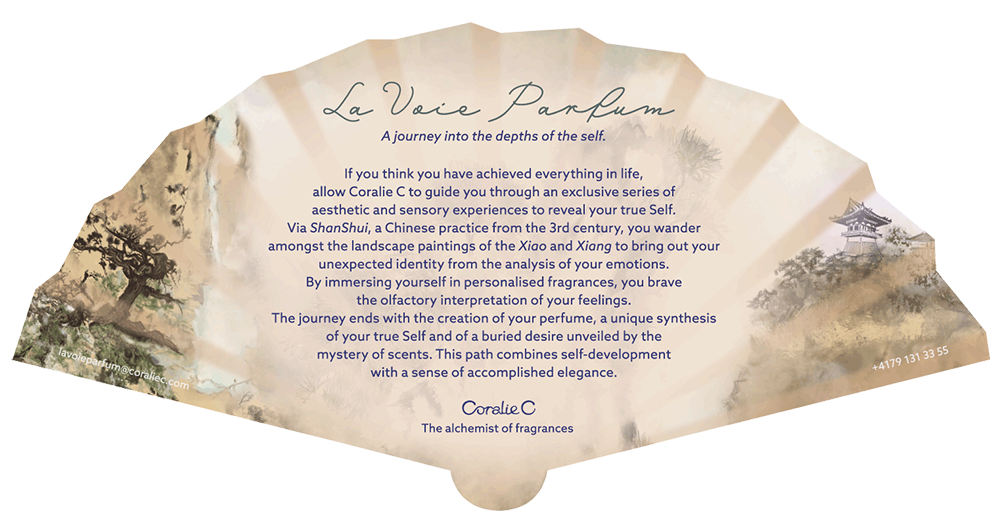What is La Voie Parfum?
Coralie C, as an alchemist, accompanies people to access their hidden self and buried desires, enable them to emerge as a whole individual.
Starting with different readings such as astrological symbolism, Landscape Identity, and an olfactive journey, she reveals their resources and the opportunity to bloom in their singular way.
These precious materials gain their ultimate meaning when they end in a genuine transformation. Therefore, through her life guidance and a process of sessions, she helps her clients to access their full potential and to change their lives.
These three interpretations are the premises of a journey that consists of identifying the hidden part and buried desires enslaved by the self-image.
Her high-end clients come from different backgrounds such as from high Jewelry, finance, and art. Their challenging expectations combine luxury and sense of art with self-care, through a unique experiential journey of their unexplored side.
If the seeker embarks on the journey, the transformation will be converted into fragrances of a unique formula. This treasure is encapsulated into a perfume that radiates their living signature.
This takes place through a spiritual process to emerge as the grail of the individual. Thus unfolds the genesis of a new life.
An olfactive language inspired from Middle-Age Japanese poetry.
I created an olfactive language by associating the kigo, seasonal words from the Yamamoto Saijiki to the features of individuals.
This list of seasonal expressions is used in Japanese poetry. From it I conceived 8 archetypes, patterns of behaviour – formula of fragrances – in resonance with 8 half seasons. Finally, I linked each archetype to an emblematic painted landscape of the Xiao and Xiang.
My own interpretation of Landscapes of the Xiao and Xiang (Song Period) inspired by the 15th century mitate paradigm is a way to see life as you want.
I painted my own interpretations of the landscapes of Xiao and Xiang according to the Japanese concept mitate. Augustin Berque, the French orientalist, explained that mitate appeared in 15th century in Japan, based on the Chinese model of Xiao and Xiang (Song period). It embodies the principle of the metaphor, ‘see…as’.
Japanese painters were able to paint the Xiao and Xiang without being there physically. It became a paradigm.
An example of the Mitate paradigm is the bonsaï. It was created to symbolise the forest at home.
This quest of the unexplored is conceived as an aesthetic approach, not a therapeutic one. The mindset requested is to look at your life as a work of Art.
The whole path corresponds to the alchemy of the being.
This is called La Voie Parfum.
La Voie Parfum is a compilation of our little ephemeral moments, encapsulated in a formula of fragrances.
The aesthetics of Wabi-sabi which has its origin in the aesthetic tradition of eremitism, from China in the Heian period, is defined as the aesthetics of ephemerality. Wabi means emptiness, while Sabi describes the melancholy, the impermanence of existence. This ideal comes from the aesthetics of the Chinese anchorites of the Six Dynasties (3rd-6th century).
This touching beauty of things that bear the trace of the passage of time or our existence, bringing out the feeling of a hush melancholy mixed with a spiritual longing, is definitely a mindset. This is conveyed through acceptance and contemplation of our life where imperfection marks / defines our humanity. At its roots, La Voie Parfum is intrinsically an aestheticization of our life – even though an elegantly accomplished life.
Entrusting one’s thoughts to things (“Confier sa pensée aux choses”) a way to overcome our ephemeral existence.
From the Manyôshû onwards, compiled in the seventh century, the earliest existing anthology of Japanese poems, the principle of « entrusting one’s thoughts to things (mono ni yosete omoi wo nobu 寄物陳思) is asserted; that is to say, evoking things is tantamount to evoking the feelings that go along with them, without needing to say these expressly. (Augustin Berque).
How to embark on the Journey?
What is La Voie Parfum?
The Method
About Coralie


